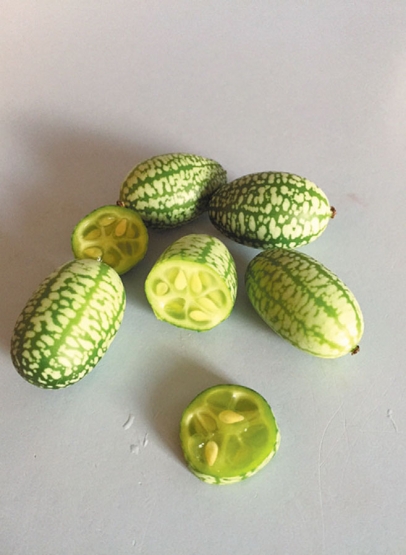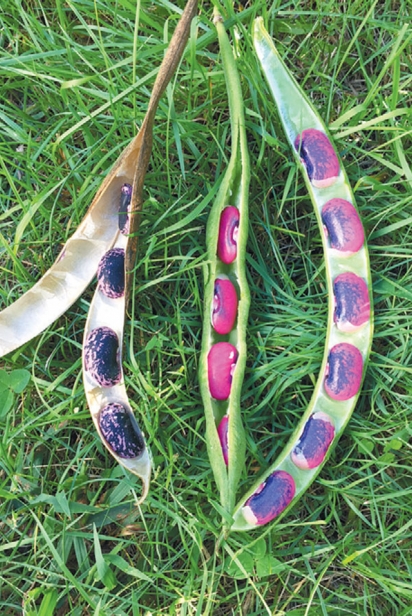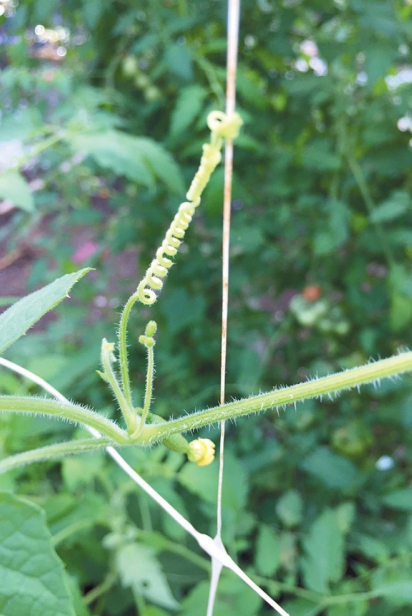Mouse Melons, Magic Beans & Climbing Trombones
When the summer garden begins to wane and the weeds that once triumphed begin to wither away, the garden victors raise their heads high above the wilting, shrinking scoundrels.
There wasn’t much that could withstand the relentless heat and drought or survive in the shadow of the incessant summer weeds, but in my garden, with little more care than the planting of the seed, if that, late summer always brings a plentiful, and unique, edible bounty. It comes from three climbing vines that are just coming into their glory as the rest of the garden slips away.
Their strategy of surviving the onslaught of competing, ramped summer growth and retaining a piece of garden real estate is simple: they climb. They climb and twine over other plants to reach sunlight without wasting energy on growing their own self-supporting stems. This may appear simple but climbing plants have been puzzling biologists for centuries. The technique the plants use to winch themselves upwards is well known, but the underlying mechanism is somewhat of a mystery.
Some climbers twine their stems in a clockwise direction, others counterclockwise, and still others have tendrils that develop into springs, like a car suspension unit. When first formed, a tendril is almost straight, and while growing it slowly waves around in a little-understood process called circumnutation. Once it finds a support on which to secure itself, the end of the tendril grabs on. The tendril then shortens by coiling up into a corkscrew, pulling up the rest of the plant. But rather than twisting only in one direction, which is impossible without twisting the plant at the other end, the two halves of the coiled section curl up in opposite directions, separated by an uncoiled stretch, thus creating a twist-less spring! All in all this incredible feat of nature has secured success for these late blooming gifts of the season.
The tiny mouse melon, sometimes referred to as dolly watermelon, or Mexican sour gherkin because of its diminutive size and dark green stripes on a light background, waves its tiny tendrils in the breeze searching for a foothold to the sky. Even the slightest touch of a hair passing over the tendril will spring it into action. Despite its sour cucumber-like taste and watermelon look, it surprisingly is neither a watermelon nor a true cucumber. Although it is in the family Cucurbitaceae, as are slicing cucumbers, only one species within that family is considered a proper salad cucumber, Cucumis sativus, while the mouse melon belong to another genus entirely, Melothria scabra. Native to Central America and Mexico, the mouse melon was first classified by French botanist Charles Victor Naudin in 1866, but is believed to have been used for both medicine and food since ancient times.
While the rest of the summer plants are producing fruits, then wildly sprawling out of control, the mouse melon’s tiny, dainty leaves and fine stems are twining delicately up trellises, walls, fences and fading garden plants. Miniature “watermelons” dangle like hanging ornaments from below the leaves. Although slow-growing while establishing themselves, the plant can eventually grow up to ten feet. It is an adorable plant that covers a lot of ground, slowly but surely. It is quite attractive in hanging baskets as well. It self-seeds yearly, so even if you’ve forgotten to plant it or are late to plant, it will reappear, most likely exactly where it left off last season. Alternatively, the roots can be dug and stored during winter to be replanted in spring. Mouse melon is not affected by drought, pests or disease, and it is effortless to grow. By late summer (70 days to maturity) the vines are covered with edible, cucumber-like, tart fruits, sort of a cross between a cucumber and a lime. Pickles are their traditional use but sliced and salted like its cousin the cucumber, added to a salad, salsa or even sauteed in oil and garlic, your imagination is the limit. They are a food artist’s dream.
They have become quite popular at farmers’ markets and restaurants as a specialty item, crazy and unusual. They are a special treat that combines an edible harvest with a beautiful addition to the ornamental garden. If you want to save seeds, choose the ripest fruits, the little melons that have dropped to the ground. Properly stored, the seed can remain viable eight to ten years. Sow in April to May for harvesting July to September.
Another exceptional climber and dual purpose vegetable/ornamental plant is the scarlet runner bean, with its towering vines and sweet-pealike clusters of crimson flowers blooming prolifically all summer long. Thought of as an ornamental in this country, runners were used as a food source in many parts of the Americas before the arrival of Europeans. Native Americans consumed almost every part of the plant. It not only produces stunningly brilliant flowers that attract both hummingbirds and bees in great numbers, but it also yields a never-ending supply of incredibly delicious beans. It is agreed upon by many that if gathered at the proper time, when the seed is just perceptible, they are superior to any of the common beans. As a bonus, the crimson blossoms are considered one of the best edible flowers. The only reason you don’t see runners at supermarkets is because they don’t store or ship well. Picking daily is essential to keep the 10- to 15-foot vines producing haricot vert-type pods, but don’t be alarmed if you can’t keep up with the harvest. Even the oversized beans are more than edible, they are delicious (typically “frenched” at a larger size), and they keep producing right up through a few light frosts.
If planted early enough in the season (and they thrive in cool weather, being native to cooler, high-altitude regions), the pods can be left to dry brown on the vines, then harvested and shelled for winter. The dry beans are so beautiful you’ll be tempted to display them rather than eat them. What more could you ask of a plant?
In their native habitat, runner beans are perennial. The indigenous people of the region originally used it in the infamous Three Sisters companion planting of corn, beans and squash. The starchy roots get so big in central and northern South America (Mesoamerica) that they are used as food. The thick tuberous root can also be lifted in the fall and stored like a dahlia. Vines from tubers produce more abundant crops of beans than those raised annually from seed. The tubers can be started in pots early in the spring, either in a cold frame or in a greenhouse, and the plants will have a head start when they are set out.
Runner beans have been domesticated for more than 2000 years, and although wild, small-podded, short day plants (that will not initiate flowering if the nights are less than ten hours long) are still found growing in the cool, partially shaded valleys of mixed pine-oak forests in Guatemala and Mexico, the runner beans we grow today are very much improved. Records show that the bean was introduced to Spain following Columbus’s second voyage to the New World in 1493, and then spread into the eastern Mediterranean. By the seventeenth century it was widely cultivated there and was also being grown in northern Europe as an ornamental. John Tradescant (gardener to King Charles I) recorded it in a list of his plants in 1634.
In Europe it would not have flowered until late August or September and would have produced very few ripe seeds. With time and selection, the runner bean became day-length neutral, flowering early enough for pods to develop in Northern Europe, and with this its use as a food crop increased. When it once again returned to the Americas, interest increased in exhibiting the runner bean, and breeding the plant to improve upon the bean size, flavor and flower color varieties. White flowered cultivars are popular with commercial growers because they lack the anthocyanin that is present in red flowers, and suffer less from bruising when transported. If the breeders are successful, perhaps someday we will find them available in our local supermarkets.
The next productive garden oddity has been referred to as “The Zucchini That Ate Manhattan,” by organic farmer/author Eliot Coleman. It has blooms the size of a dinner plate, fruit that can grow three to four feet long, and can climb 20 feet to the top of an apple tree. Italians prize this heirloom for stuffing in gnocchi and ravioli and it makes a wonderful fall soup or pie. This exuberant and prolific vegetable is the tromboncino rampicante squash. If you have a small space and need plants that perform more than one duty on the vertical or on a quick-cover, trellised privacy fence, tromboncino is the answer. It is one of the few winter squash that can also be harvested as summer squash. It can be consumed fresh when young and eaten like a summer squash or left to mature until it cures and turns tan in color. Either way it is delicious and very easy to prepare as its entire seed cavity is located in its small bulbous end. This plant is relatively carefree, other than perhaps guiding it on a chosen path; neither pest nor pathogen seems to faze it, nor do the cooling temperatures of fall.
Tromboncino belongs to the genus Cucurbita (family Cucurbitaceae) and is native to the Americas. The three main cultivated species of Cucurbita, of worldwide economic importance, are Cucurbita pepo, C. maxima and C. moschata. Tromboncino squash is botanically classified as Cucurbita moschata, as are our familiar hardy butternut squash, and like it is very disease resistant and adaptable. Unlike the other two species, C. moschata has not yet been recorded as growing wild, although it is considered to be the purest species of the three with the most ancestral-like genome. C. moschata is referred to as a “tropical pumpkin”, as the center of diversity of the species lies in the tropics rather than in the temperate zone as is the case with the other two important pumpkin species. Tropical pumpkins are consumed primarily near to where they are grown on small family farms. Most are landrace, locally adapted, traditional cultivars, rather than commercial cultivars that we might see in the supermarkets. It is more tolerant of heat and humidity than any other domesticated species of squash. Once plants are established, they are able to withstand not just wet conditions, but dry conditions as well. The fruits of these squash are often covered with a waxy film that protects it from the intense tropical sun as well as insect and pathogens giving them a superb ability to ward off anything nature can throw at them. Nutritionally, tropical pumpkins are high in carotenoids, and vitamin A. Even the immature fruits of tromboncino are reputed to be a better source of vitamin A and C than the typical summer squashes.
They are such hardy plants that some tropical pumpkins are being tested as a rootstock for other less hardy Cucurbita species, such as melons. Within the genus C. mochata there is enormous genetic diversity that is still largely untapped by scientific breeders.
Tromboncino is a plant that commands attention in the garden with its mottled leaves, great ability to climb and unusually long or twisting fruits. Trellised, many of the fruits grow long and straight, but as soon as the fruit reaches the ground, these squash take on their “trombone” shapes for which they are named.
It may be slower to begin producing than other species of squash, but once it starts you’ll be glad it was late! The harvest is so enormous from only a plant or two that you will be generously sharing it with the neighbors. When all the other squash in the garden have succumbed to cooling fall temperatures and disease, the tromboncino is in its glory, producing squash right up to the first frost. In my garden, by mid-October you’ll find tromboncinos hanging from my fruit trees top to bottom!
One of the best rewards of summer gardens and local markets is the unusual varieties of produce that can be had for a few months each year, vegetables and fruits never seen in the supermarkets. I remember that when we first started farmers’ markets on Cape Cod, venders noticed that the novelty produce rarely sold. People were interested but chose to buy the familiar instead. All that has definitely changed. The seed catalogs are now filled with bizarre and unusual seeds, and gardeners are always on the hunt for new and unusual vegetables. If you are looking for something unique and haven’t yet tried these three climbing vegetables, I highly recommend the mouse melon, scarlet runner bean, and tromboncino for both their ornamental value and late season bounty.








